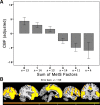Obesity-induced cognitive impairment in older adults: a microvascular perspective
- PMID: 33337961
- PMCID: PMC8091942
- DOI: 10.1152/ajpheart.00736.2020
Obesity-induced cognitive impairment in older adults: a microvascular perspective
Abstract
Over two-thirds of individuals aged 65 and older are obese or overweight in the United States. Epidemiological data show an association between the degree of adiposity and cognitive dysfunction in the elderly. In this review, the pathophysiological roles of microvascular mechanisms, including impaired endothelial function and neurovascular coupling responses, microvascular rarefaction, and blood-brain barrier disruption in the genesis of cognitive impairment in geriatric obesity are considered. The potential contribution of adipose-derived factors and fundamental cellular and molecular mechanisms of senescence to exacerbated obesity-induced cerebromicrovascular impairment and cognitive decline in aging are discussed.
Keywords: aging; endothelial dysfunction; metabolic syndrome; neurovascular coupling; senescence.
Conflict of interest statement
No conflicts of interest, financial or otherwise, are declared by the authors.
Figures





Similar articles
-
Impaired neurovascular coupling in aging and Alzheimer's disease: Contribution of astrocyte dysfunction and endothelial impairment to cognitive decline.Exp Gerontol. 2017 Aug;94:52-58. doi: 10.1016/j.exger.2016.11.004. Epub 2016 Nov 12. Exp Gerontol. 2017. PMID: 27845201 Free PMC article. Review.
-
Senescent Endothelial Cells in Cerebral Microcirculation Are Key Drivers of Age-Related Blood-Brain Barrier Disruption, Microvascular Rarefaction, and Neurovascular Coupling Impairment in Mice.Aging Cell. 2025 Jul;24(7):e70048. doi: 10.1111/acel.70048. Epub 2025 Apr 1. Aging Cell. 2025. PMID: 40167015 Free PMC article.
-
Functional vascular contributions to cognitive impairment and dementia: mechanisms and consequences of cerebral autoregulatory dysfunction, endothelial impairment, and neurovascular uncoupling in aging.Am J Physiol Heart Circ Physiol. 2017 Jan 1;312(1):H1-H20. doi: 10.1152/ajpheart.00581.2016. Epub 2016 Oct 28. Am J Physiol Heart Circ Physiol. 2017. PMID: 27793855 Free PMC article. Review.
-
Aging exacerbates obesity-induced cerebromicrovascular rarefaction, neurovascular uncoupling, and cognitive decline in mice.J Gerontol A Biol Sci Med Sci. 2014 Nov;69(11):1339-52. doi: 10.1093/gerona/glu080. Epub 2014 Jun 3. J Gerontol A Biol Sci Med Sci. 2014. PMID: 24895269 Free PMC article.
-
Fusogenic liposomes effectively deliver resveratrol to the cerebral microcirculation and improve endothelium-dependent neurovascular coupling responses in aged mice.Geroscience. 2019 Dec;41(6):711-725. doi: 10.1007/s11357-019-00102-1. Epub 2019 Oct 25. Geroscience. 2019. PMID: 31654270 Free PMC article.
Cited by
-
Diabetes: Risk factor and translational therapeutic implications for Alzheimer's disease.Eur J Neurosci. 2022 Nov;56(9):5727-5757. doi: 10.1111/ejn.15619. Epub 2022 Feb 23. Eur J Neurosci. 2022. PMID: 35128745 Free PMC article.
-
Effects of follicle-stimulating hormone on fat metabolism and cognitive impairment in women during menopause.Front Physiol. 2022 Dec 5;13:1043237. doi: 10.3389/fphys.2022.1043237. eCollection 2022. Front Physiol. 2022. PMID: 36545281 Free PMC article. Review.
-
Type 2 Diabetes and Alzheimer's Disease: The Emerging Role of Cellular Lipotoxicity.Biomolecules. 2023 Jan 16;13(1):183. doi: 10.3390/biom13010183. Biomolecules. 2023. PMID: 36671568 Free PMC article. Review.
-
Environmental Enrichment and Metformin Improve Metabolic Functions, Hippocampal Neuron Survival, and Hippocampal-Dependent Memory in High-Fat/High-Sucrose Diet-Induced Type 2 Diabetic Rats.Biology (Basel). 2023 Mar 21;12(3):480. doi: 10.3390/biology12030480. Biology (Basel). 2023. PMID: 36979171 Free PMC article.
-
The role of neurovascular coupling dysfunction in cognitive decline of diabetes patients.Front Neurosci. 2024 Mar 21;18:1375908. doi: 10.3389/fnins.2024.1375908. eCollection 2024. Front Neurosci. 2024. PMID: 38576869 Free PMC article. Review.
References
Publication types
MeSH terms
Grants and funding
LinkOut - more resources
Full Text Sources
Other Literature Sources
Medical

